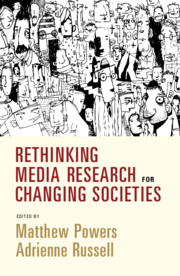Book contents
- Rethinking Media Research for Changing Societies
- Communication, Society and Politics
- Rethinking Media Research for Changing Societies
- Copyright page
- Contents
- Figure
- Contributors
- Acknowledgments
- 1 Introduction
- Part I Living in a Datafied World
- 2 The Corporate Reconfiguration of the Social World
- 3 Public Communication in a Promotional Culture
- Part II Journalism in Times of Change
- Part III Media and Problems of Inclusion
- Part IV Engagement with and through Media
- Part V The Role of Scholars
- Other Books in the Series (continued from page ii)
- References
3 - Public Communication in a Promotional Culture
from Part I - Living in a Datafied World
Published online by Cambridge University Press: 18 September 2020
- Rethinking Media Research for Changing Societies
- Communication, Society and Politics
- Rethinking Media Research for Changing Societies
- Copyright page
- Contents
- Figure
- Contributors
- Acknowledgments
- 1 Introduction
- Part I Living in a Datafied World
- 2 The Corporate Reconfiguration of the Social World
- 3 Public Communication in a Promotional Culture
- Part II Journalism in Times of Change
- Part III Media and Problems of Inclusion
- Part IV Engagement with and through Media
- Part V The Role of Scholars
- Other Books in the Series (continued from page ii)
- References
Summary
This chapter explores the ways that private media companies take users’ personal data as a proxy for public life, and discusses the consequences this development poses for public knowledge. In contrast to sweeping claims about the efficacy of data analytics, Melissa Aronczyk argues that the data these companies collect are often relevant only to specific behaviors carried out in a predetermined context. They reflect a system engineered to maximize attention and profit while adhering to security and privacy regulations. The resulting data set thus are highly specific to the conditions in which they are produced and cannot stand in for any more general public opinion. Aronczyk discusses the United Nations’ use of datasets donated by private companies to address their agenda for climate mitigation, and questions the reliability of that data for making inferences about human behavior. More broadly, she interrogates the wisdom of taking our cues from corporations by adopting the same assumption they make about what their data means.
- Type
- Chapter
- Information
- Rethinking Media Research for Changing Societies , pp. 39 - 50Publisher: Cambridge University PressPrint publication year: 2020
References
- 1
- Cited by



